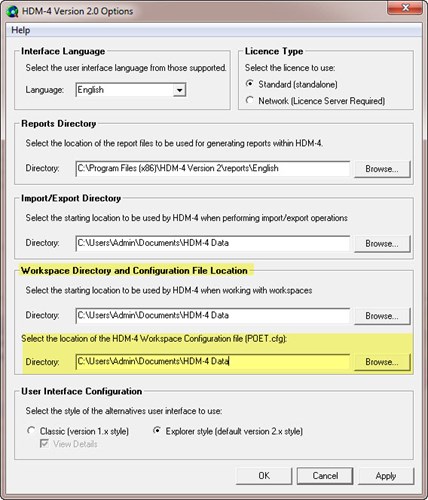Build and manage better road networks
- Home
- Services
- Knowledge Base
- HDM-4 Workspace
HDM-4 Workspace
-
KB0000052 : When trying to open a HDM-4 Workspace the error number '-2032' is received
Error -2032:
Symptoms:
When starting HDM-4 or opening a HDM-4 Workspace the following error is received:
Unable to connect to database. Technical Support Error Reference = -2032.
Cause :
The error received is generated from the database used by HDM-4 and in detail is described as follows:
"You do not have the right file permissions to access your database files. If you are using a server, make sure that it has the file permissions to open the database. If you are in local mode, make sure that your process has these permissions and that no other application has opened the database files. C 1997 POET Software"
There are three common reasons why this error is generated:
1. You have more than one HDM-4 application running on the PC at the same time.
2. The database files are read-only (a common cause of this is when the files have been copied or restored from a back-up media, such as a CDR).
3. If you are running HDM-4 on windows NT or XP/Vista/Windows 7, or accessing the database over a network, you do not have write permission for the database files.
Solution :
To resolve this problem you should check the following:
1. Ensure that you have only one copy of HDM-4 running on the PC.
2. Ensure that the Workspace files (objects.dat & objects.idx) are not read-only.
3. If you are using windows 2000/XP/Vista/Windows 7, or accessing the workspace over a network ensure that you have the security permissions to write to the workspace files (objects.dat * objects.idx).
-
KB0000051 : When trying to open a HDM-4 Workspace the error number '-2071' is received
Symptoms:
When starting HDM-4 or opening a HDM-4 Workspace the following error is received:
Unable to connect to database. Technical Support Error Reference = -2071.
Causes:
There are two common reasons the error -2071 is received:Cause [1]:
You should ensure that you are trying to open a HDM-4 version 2 workspace and not a HDM-4 Version 1.3 workspace. You cannot open a HDM-4 Version 1.3 database with HDM-4 Version 2 - the two databases are different because of the changes that have been made to the way data is stored and entered.Cause [2]:
The error -2071 can also indicate that the workspace you are trying to open could not find the database dictionary that is required to open the file. Typically this is located in "C:\Program Files\HDM-4 Version 2". There is an initialisation file that tells HDM-4 where the default dictionary can be found, POET.CFG.- The dictionary files may be missing
- POET.CFG incorrectly formatted, or
- Due to the operating system configuration the dictionary files may be protected from access
Solutions:
Solution [1]:
If you wish to use the HDM-4 Version 1.3 data within HDM-4 Version 2 you must convert that data to a format it can read. To do this, when HDM-4 is installed, it also installs a "HDM-4 Data Migration Tool" which can be used to convert the data.Solution [2]:
HDM-4 Version 2.0 -> HDM-4 Version 2.04
The POET.CFG file is located in the directory that HDM-4 Version 2 software was installed in, typically this will be "C:\Program Files\HDM-4 Version 2\hdmdict". Go to this directory and open POET.CFG. You should see entries similar to this:
[schemata\HDMDICT]
name = C:\Program Files\HDM-4 Version 2\HDMDICTWithin the directory defined there should be two files: _objects.dat and _objects.idx. If these are not present then the software should be reinstalled or the files copied from another PC. If the dictionary files exist but in a different directory, <Dictionary directory>, you should edit the "name = ..." text in POET.CFG to "name = <dictionary directory>" and save the file.
The user should have read/write access to these files and directory (POET.CFG, and dictonary files). If this is not the case you should update your software to the latest version of the software to take advantage of the enhanced configuration available.
HDM-4 Version 2.05+
In HDM-4 v2.05+ you can specify where HDM-4 looks to find the POET.CFG file. You should ensure that this location is correctly set up by opening the "HDM-4 Version 2 Options Tool" (found in the HDM-4 Version 2/Tools program group menu) towards the bottom the section "Workspace Directory and Configuration File Location". The location specified you be the directory in which POET.CFG file is defined. Use the browse button to select the correct directory.
In the example below the POET.CFG is located in the user-area "c:\users\Admin\Documents\HDM-4 Data".

This functionality enables the user to place the configuration file and dictionary files into a location they have read/write access such as "my documents" or similar. If read/write access issue is suspected you should move the POET.CFG file and related HDMDICT directory and configure the POET.CFG file (see above) and "Workspace Directory and Configuration File Location" appropriately.
-
KB0000061: When trying to open a HDM-4 Workspace the error number "-2614" is received
Error -2614:
Symptoms:
When starting HDM-4 or opening a HDM-4 Workspace the following error is received:
Unable to connect to database. Technical Support Error Reference = -2614
Cause :
The data file (objects.dat), the index file (objects.idx) and the recovery file (data0000.rcy, by default in the subfolder “Recovery”) contain a creation and modification timestamp. These timestamps are used to check whether these files belong together to define the workspace.
If one of the timestamps does not match the others, the database cannot be opened, in which case this code is returned. Generation of the error code prevents the database from being damaged as the result of an outdated recovery file or non-matching index file.
It is necessary to check the date stamps of the workspace files that you or another user are trying to open to ensure they are consistent.
Solution :
If you have copied the files from another PC, ensure all of the above files are copied and any existing files are over-written.
If you did not copy the recovery files, delete the recovery subfolder to ensure old files are not being used – when restarting the software will ask if you wish to continue without the use of the recovery files so you can continue. Click on Yes/OK to continue.
-
KB0000060: How to backup or send your complete workspace to another person
Issue
You wish to take a copy of your whole workspace to you can backup your data to another device
You wish to send your complete workspace to another HDM-4 user (for instance, a colleague, a reviewer, technical support, etc)
Background
All HDM-4 data (Road Networks, Vehicles Fleets, Maintenance Stds, etc) are stored in a single database which can only be read and written to by the HDM-4 software.
The complete database is made up of several files and folders which are structured as follows:
<workspace folder>
objects.dat *
objects.idx *
+ eventlog
f0000000.ptd
+ recovery
data0000.rcy
Solution
You should first locate the location of the workspace folder on your PC. This can be done with the workspace open in HDM-4 and noting the directory path shown at the top of the main workspace window, as shown below:

Close HDM-4 to ensure the latest data has been saved to the workspace.
Open the File Explorer and navigate to the highlighted folder (F:\Admin\Documents\HDM-4 Data\Case Studies\Eng in the above example). You should see the workspace files and folders as highlighted above.
To backup the files:
Copy the folder and paste to to your backup media (USB drive, external hard disk, cloud storage, etc). Alternatively you can follow the instructions below to create a single compressed file to copy to your back up media.
To copy and send the files:
Right-click the workspace folder, point to the menu option Send to, and then click Compressed (zipped) folder. A new compressed folder will be created in the same location as the workspace folder. If you wish to rename it, right-click the folder, click Rename, and then type the new name.
The compressed file can now be sent to the required person.
NOTE: When backing up your files it is important to check the date stamp on the files to confirm that you are backing up the latest files.
If your workspace is stored in a folder under the Program Files (for instance, “C:\Program Files (x86)\HDM-4 Version 2\Case Studies\Eng”) security permissions may prevent you from writing data to the workspace files contained in that folder. In these circumstances Windows automatically creates the files in a different folder (a Virtual Store) so you can write your data to the files, but it appears as if the files are in the folder under the program files path. This is a function of Windows to allow those without administrator privileges to continue to use applications that store their files in protected folders.
The exact location of this “virtual store” can vary depending on your PCs configuration, but a typical example is shown below:
If the direct address is:
C:\Program Files (x86)\HDM-4 Version 2\Case Studies\Eng
It may actually be stored in the following location:
%LocalAppData%\VirtualStore\Program Files (x86)\HDM-4 Version 2\Case Studies\Eng
The location of %LocalAppData% will be different on each person’s PC however, if the user's name is "Admin" it will typically be found in the following folder:
C:\Users\Admin\AppData\Local\VirtualStore\Program Files (x86)\HDM-4 Version 2\Case Studies\Eng
You may need to enable hidden folders / files view to be able to see these files - open windows explorer and then click on “Organize” and select the menu item “Folder and search options” – in the window that opens click on “view” and you will see a list of advanced options - Click on “show hidden files, folders, and drives” and also unchecked "Hide protected operating system files".
-
Find out about the technical support service offered by HDMGlobal to help users use HDM-4 effectively.
-
For existing HDM-4 users, view the latest software release and the changes made before registering to receive the updates.
-
Find out about HDM-4 training courses offered by HDMGlobal and their partner organisations and other related events.








